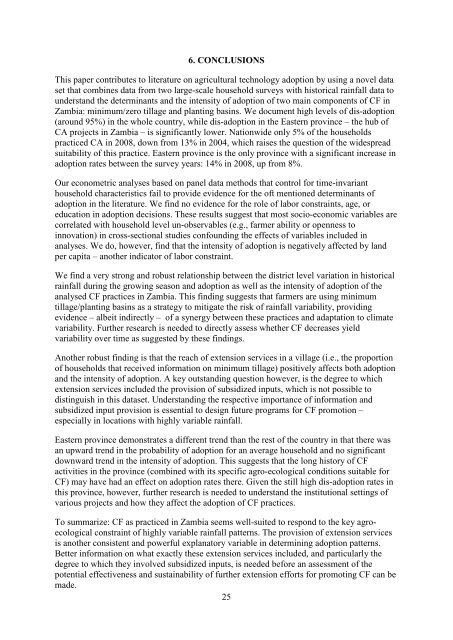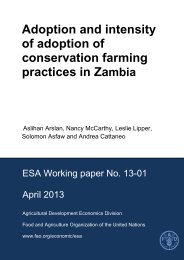Adoption and intensity of adoption of conservation farming practices in Zambia
Adoption and intensity of adoption of conservation farming practices in Zambia
Adoption and intensity of adoption of conservation farming practices in Zambia
You also want an ePaper? Increase the reach of your titles
YUMPU automatically turns print PDFs into web optimized ePapers that Google loves.
6. CONCLUSIONS<br />
This paper contributes to literature on agricultural technology <strong>adoption</strong> by us<strong>in</strong>g a novel data<br />
set that comb<strong>in</strong>es data from two large-scale household surveys with historical ra<strong>in</strong>fall data to<br />
underst<strong>and</strong> the determ<strong>in</strong>ants <strong>and</strong> the <strong><strong>in</strong>tensity</strong> <strong>of</strong> <strong>adoption</strong> <strong>of</strong> two ma<strong>in</strong> components <strong>of</strong> CF <strong>in</strong><br />
<strong>Zambia</strong>: m<strong>in</strong>imum/zero tillage <strong>and</strong> plant<strong>in</strong>g bas<strong>in</strong>s. We document high levels <strong>of</strong> dis-<strong>adoption</strong><br />
(around 95%) <strong>in</strong> the whole country, while dis-<strong>adoption</strong> <strong>in</strong> the Eastern prov<strong>in</strong>ce – the hub <strong>of</strong><br />
CA projects <strong>in</strong> <strong>Zambia</strong> – is significantly lower. Nationwide only 5% <strong>of</strong> the households<br />
practiced CA <strong>in</strong> 2008, down from 13% <strong>in</strong> 2004, which raises the question <strong>of</strong> the widespread<br />
suitability <strong>of</strong> this practice. Eastern prov<strong>in</strong>ce is the only prov<strong>in</strong>ce with a significant <strong>in</strong>crease <strong>in</strong><br />
<strong>adoption</strong> rates between the survey years: 14% <strong>in</strong> 2008, up from 8%.<br />
Our econometric analyses based on panel data methods that control for time-<strong>in</strong>variant<br />
household characteristics fail to provide evidence for the <strong>of</strong>t mentioned determ<strong>in</strong>ants <strong>of</strong><br />
<strong>adoption</strong> <strong>in</strong> the literature. We f<strong>in</strong>d no evidence for the role <strong>of</strong> labor constra<strong>in</strong>ts, age, or<br />
education <strong>in</strong> <strong>adoption</strong> decisions. These results suggest that most socio-economic variables are<br />
correlated with household level un-observables (e.g., farmer ability or openness to<br />
<strong>in</strong>novation) <strong>in</strong> cross-sectional studies confound<strong>in</strong>g the effects <strong>of</strong> variables <strong>in</strong>cluded <strong>in</strong><br />
analyses. We do, however, f<strong>in</strong>d that the <strong><strong>in</strong>tensity</strong> <strong>of</strong> <strong>adoption</strong> is negatively affected by l<strong>and</strong><br />
per capita – another <strong>in</strong>dicator <strong>of</strong> labor constra<strong>in</strong>t.<br />
We f<strong>in</strong>d a very strong <strong>and</strong> robust relationship between the district level variation <strong>in</strong> historical<br />
ra<strong>in</strong>fall dur<strong>in</strong>g the grow<strong>in</strong>g season <strong>and</strong> <strong>adoption</strong> as well as the <strong><strong>in</strong>tensity</strong> <strong>of</strong> <strong>adoption</strong> <strong>of</strong> the<br />
analysed CF <strong>practices</strong> <strong>in</strong> <strong>Zambia</strong>. This f<strong>in</strong>d<strong>in</strong>g suggests that farmers are us<strong>in</strong>g m<strong>in</strong>imum<br />
tillage/plant<strong>in</strong>g bas<strong>in</strong>s as a strategy to mitigate the risk <strong>of</strong> ra<strong>in</strong>fall variability, provid<strong>in</strong>g<br />
evidence – albeit <strong>in</strong>directly – <strong>of</strong> a synergy between these <strong>practices</strong> <strong>and</strong> adaptation to climate<br />
variability. Further research is needed to directly assess whether CF decreases yield<br />
variability over time as suggested by these f<strong>in</strong>d<strong>in</strong>gs.<br />
Another robust f<strong>in</strong>d<strong>in</strong>g is that the reach <strong>of</strong> extension services <strong>in</strong> a village (i.e., the proportion<br />
<strong>of</strong> households that received <strong>in</strong>formation on m<strong>in</strong>imum tillage) positively affects both <strong>adoption</strong><br />
<strong>and</strong> the <strong><strong>in</strong>tensity</strong> <strong>of</strong> <strong>adoption</strong>. A key outst<strong>and</strong><strong>in</strong>g question however, is the degree to which<br />
extension services <strong>in</strong>cluded the provision <strong>of</strong> subsidized <strong>in</strong>puts, which is not possible to<br />
dist<strong>in</strong>guish <strong>in</strong> this dataset. Underst<strong>and</strong><strong>in</strong>g the respective importance <strong>of</strong> <strong>in</strong>formation <strong>and</strong><br />
subsidized <strong>in</strong>put provision is essential to design future programs for CF promotion –<br />
especially <strong>in</strong> locations with highly variable ra<strong>in</strong>fall.<br />
Eastern prov<strong>in</strong>ce demonstrates a different trend than the rest <strong>of</strong> the country <strong>in</strong> that there was<br />
an upward trend <strong>in</strong> the probability <strong>of</strong> <strong>adoption</strong> for an average household <strong>and</strong> no significant<br />
downward trend <strong>in</strong> the <strong><strong>in</strong>tensity</strong> <strong>of</strong> <strong>adoption</strong>. This suggests that the long history <strong>of</strong> CF<br />
activities <strong>in</strong> the prov<strong>in</strong>ce (comb<strong>in</strong>ed with its specific agro-ecological conditions suitable for<br />
CF) may have had an effect on <strong>adoption</strong> rates there. Given the still high dis-<strong>adoption</strong> rates <strong>in</strong><br />
this prov<strong>in</strong>ce, however, further research is needed to underst<strong>and</strong> the <strong>in</strong>stitutional sett<strong>in</strong>gs <strong>of</strong><br />
various projects <strong>and</strong> how they affect the <strong>adoption</strong> <strong>of</strong> CF <strong>practices</strong>.<br />
To summarize: CF as practiced <strong>in</strong> <strong>Zambia</strong> seems well-suited to respond to the key agroecological<br />
constra<strong>in</strong>t <strong>of</strong> highly variable ra<strong>in</strong>fall patterns. The provision <strong>of</strong> extension services<br />
is another consistent <strong>and</strong> powerful explanatory variable <strong>in</strong> determ<strong>in</strong><strong>in</strong>g <strong>adoption</strong> patterns.<br />
Better <strong>in</strong>formation on what exactly these extension services <strong>in</strong>cluded, <strong>and</strong> particularly the<br />
degree to which they <strong>in</strong>volved subsidized <strong>in</strong>puts, is needed before an assessment <strong>of</strong> the<br />
potential effectiveness <strong>and</strong> susta<strong>in</strong>ability <strong>of</strong> further extension efforts for promot<strong>in</strong>g CF can be<br />
made.<br />
25



